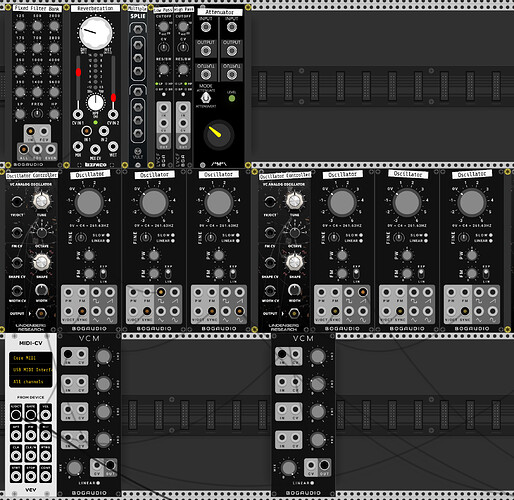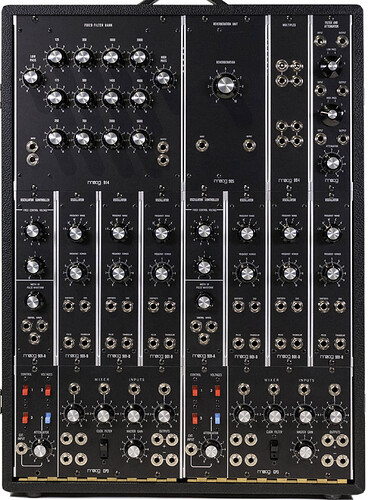The first modular cat picture? ![]()
I’m looking at these details and trying to recreate old Moog modulars in VCV much like you are.
- What is an oscillator controller? I would assume this is a keyboard, but at the bottom it says there is a keyboard controller?
- Difference between VCOs and just Os?
- What is an envelope follower and how is it different from a typical ADSR generator?
- What is a linear controller and why would I need two of them?
a envelope follower allow to you create a CV signal based en the envelope of a audio source , an example of application of it is a auto wah pedal for guitars, it use the input audio signal to control the filter
I don’t know in what context is used it, but there is a some types of envelopes, it can be linear , logarithmic or exponential or a combination of all of them, depending of what you use you can achieve very different results (perhaps it talk about the VCA?)
to control the waveform (?)
As I understand it, there is one main oscillator, the 901A, that has an output into three different 901B oscillators. The 901Bs have four waveshape outputs simultaneously. I think the 901A output would go into the 901B “sync” input?
This would be the ribbon controller on top of Micky’s Moog pictured above, I think the cat is stepping on it. ![]() It would be more for portamento effects instead of dialing into a specific note on a keyboard. Something like that, the Tannerin or Electro-Theremin, was used on The Beach Boys “Good Vibrations”. I assume we would need two of these to create the most chaos possible.
It would be more for portamento effects instead of dialing into a specific note on a keyboard. Something like that, the Tannerin or Electro-Theremin, was used on The Beach Boys “Good Vibrations”. I assume we would need two of these to create the most chaos possible. ![]()
Check out http://moogarchives.com/ and then you can use the menu on the left to navigate to “Instruments” and then “modular systems” or “modules”. There are detailed descriptions of each module.
I started building a 3P patch last night. I’ll post it here if you want when it’s a bit more playable, it’s a bit of a sketch pad right now. Here’s what it looks like:
The left panel of the 3P:
I must admit I’m pretty confused, still wrapping my head around modular myself.
901-A OSCILLATOR CONTROLLER: Used to control the frequencies of two or more 901-B oscillators (see below) so that the ratio between the frequencies of the controlled oscillators remains constant. $85.00
901-B OSCILLATOR: Provides sine, triangular, pulse, and sawtooth waveforms simultaneously over the frequency range 0.1 - 15,000 cycles per second. Two or more of these can be ganged, and their frequencies controlled from a single 901-A controller. Complex spectra and note mixtures can be produced, and can be shifted over wide frequency ranges. $125.00
It says the 901A is used to control the frequencies of 901B, yet the 901B has no inputs…So does this mean the 901B outputs go into the inputs of the 901A? I have a hunch this is why the 901A has three inputs and they pair it with only 3 901B oscillators.
How does the 901A get control voltage from a keyboard so it can play proper notes? Or was that handled differently in the 60s?
hey guys once we’re done getting the model 15 and the system 3 we should figure out this one Leonard Bernstein used
I just glanced at the spec sheet–interestingly, the 901A connected behind the panel to up to three 901Bs. The front panel jacks on the 901B output the four waveforms it generates. No modern modular would communicate pitch this way, but if you wanted to be interface-authentic to the Moog, you would need a bespoke set of modules using the Rack expander protocol (since that’s how Rack models behind-the-panel connections).
The 901A front inputs are for control voltage, and are presumably summed. So (for example) a CV keyboard output could go into one, a LFO into another, and a sequencer into the third.
Fascinating stuff!
It’s a Moog lip syncing to a tape. 
Isn’t this stuff cool? In my screenshot above, I have my 901A output going into the sync of my 901Bs, and I’m getting pitch information from my midi keyboard and it’s pretty cool right now. I’m not sure if this is the way to emulate such a thing. How do we get the expander protocol? I’m unfamiliar with that. I’m also quite new to all of this modular stuff, so this is a great way to learn I think. I’m currently having trouble with understanding the CP3 mixer below the oscillator banks. I’m going to try to carve out time tonight to work on my patch and I’ll upload a work-in-progress for you if you’d like.
Thanks for everyone’s input so far. This is a great community!
Hey, thanks to you for working on this project! It’s a neat idea and a good way to start dipping into a modular workflow.
The expander protocol is something you build in when developing modules (here’s a quick explanation in another thread), so it’d only come in to play here if someone were coding a new 901A/901B module and wanted to simulate the historical wiring approach. The sound would be the same either way–it’s just a question of whether a front panel cable is used.
I think that for this project it’s much better to depart from the design history a little and use the modern convention of front panel pitch inputs (since that way you can pick and choose oscillators). Rack modules (and modern modular design) would generally never hide a conventional input that way; back panel connections are almost always for proprietary connections between parent modules and expanders (search the Library by tag for examples).
Are you thinking about the purpose of it, or about how to emulate it? If the former, happy to help–say a bit more about what seems obscure? If the latter, here’s an interesting discussion of its particular characteristics by Chris Meyer (which you may have seen already). In particular, a clean mixer won’t get you there, because it distorted pretty easily. A lot of the available Rack mixers are ultraclean or have standard simple saturation at the rails, and I don’t know offhand if anyone has done a physical model of the CP3 in particular. The @slimechildaudio Saturating Mixer is the closest thing I know of, but it’s paid. Building a CP3-like mixer from submodules would be an interesting exercise, actually!
Thanks for the help @gc3! I just spent some time with the video you posted about the CP3. I think I understand it a bit better. I used the mixer from Count Modula for this since it has an inverted output too. I’m going to try to stick to free modules for now, but I will keep that saturating mixer in mind.
What I’m gathering so far is this. There are four sets of oscillators. Three of those have the controller going into the three 901Bs, and then there’s a separate VCO for the fourth set. Each one of those four sets has a 4-channel mixer. The four 4-channel mixers then can feed into ANOTHER 4-channel mixer on the right panel, which is the final destination of the audio signal(s) before we hear it. I’ve spent a good solid two hours just blending the different sounds from the oscillators and it’s just too much fun. I had to upload my work in progress.
I’m really stuck with the envelope section. It looks like it’s generating different envelopes, but I don’t know how to use them. This is definitely one of those experiences where the more I learn, the more I realize I have to learn.
For now, the signal is gated from the MIDI-CV. As it’s patched right now, just plug in a midi keyboard or use your computer keyboard to play some notes. Feel free to use this as a basis for your own Moog patch too.
Let me know what you think!
Moog Modular 3P.vcv (56.4 KB)
That’s got to be some kind of piece of broadcast equipment in the video, I’m guessing? Whatever it is, he plays the heck out of that prop!  Really cool to see someone tackling the laptop musician problem much earlier than I expected. I listened to some Monkees LPs when I was growing up, I had no idea they had a synth player, thanks for the interesting knowledge.
Really cool to see someone tackling the laptop musician problem much earlier than I expected. I listened to some Monkees LPs when I was growing up, I had no idea they had a synth player, thanks for the interesting knowledge.
Hi I don’t know if you’re still interested in a replica of the model III but if you are let me know and I can try and build the closest replica I can I’ve made a handful of replica synthesizers and I would be happy to try out making the synth but I only want to do it if you’re still interested in it
I just finished building a system 15 or at least the closest I can get to one
I’m wearing my Small Faces t-shirt today so Steve Marriott must be another
Yes, good old “screamin steven”! I love the small faces! heck, I even like humble pie. So, the three artful dodgers are davy jones, steve marriot, and phill collins. All three of them took their turn in the original london production.
Thank you for making the MOOG System 15, would it be possible to have a look at the patch. U could just drag n drop it onto this thread. Welcome to the VCV Rack community forum. Much appreciated.
sorry cant “Sorry, new users can not upload attachments.”
but here is the link to my patch storage
Thank you, I will have a play with this and see what noises I can make!


